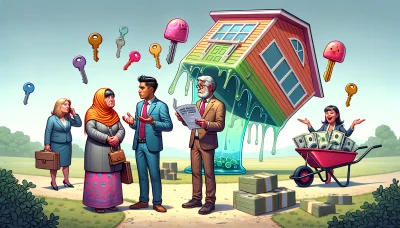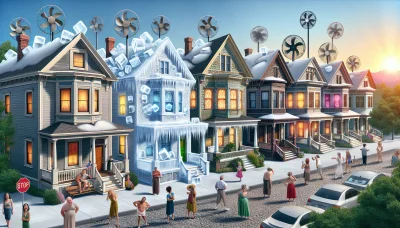Things to look for in a home inspection Quiz
Test Your Knowledge
Question of
Understanding the Basics of Home Inspections
Get ready to dive into the captivating world of home inspections! This is where safety meets savvy investment, and knowledge becomes your superpower. A home inspection is an absolute game-changer when it comes to buying or selling property. It's like having a crystal ball that reveals the secrets of a home's condition, giving you the power to make informed decisions. With a professional home inspector by your side, you'll uncover potential issues before they become expensive problems, ensuring that your dream home doesn't turn into a nightmare!
Tips and Best Practices for Home Inspections
Now, let's amp up your home inspection know-how with some electrifying tips and best practices! These nuggets of wisdom are pure gold for anyone looking to navigate the home inspection process like a pro:
- Hire a Qualified Inspector: Make sure you're enlisting a certified professional who will scrutinize every nook and cranny with an expert eye.
- Be Present During the Inspection: This is your chance to see through the lens of an expertdon't miss it! Ask questions and absorb valuable insights.
- Review the Report Thoroughly: The inspection report is packed with critical information. Review it meticulously; your future self will thank you!
- Understand Whats Covered: Know what the inspection includes and what falls outside its scopeit's crucial for setting realistic expectations.
- Plan for Additional Inspections if Necessary: Sometimes you'll need a deeper dive into specific areas. Be prepared to take that extra step for peace of mind.
- Prioritize Safety Concerns and Major Defects: These should be at the top of your list for immediate attention post-inspection.
Mistakes to Avoid During Home Inspections
The path to mastering the art of home inspections is fraught with potential pitfalls. But fear not! I'm here to illuminate those sneaky mistakes so you can sidestep them with confidence. By avoiding these common blunders, you'll emerge victorious in your real estate endeavors:
- Sidestepping Research: Don't choose an inspector on a whimresearch credentials and reviews like a detective on a mission!
- Neglecting to Attend the Inspection: Skipping out on this event is like throwing away a golden ticketbe there or risk missing out on crucial insights!
- Glossing Over the Report: Treat the inspection report as sacred textskimming it just won't cut it if you want to grasp every detail.
- Focusing Solely on Cosmetic Issues: Superficial flaws can be distracting; keep your eyes on the prize by concentrating on substantive defects that affect value and safety.
- Ignores Expert Advice: When an inspector speaks, listen up! Their advice isn't just chatter; it's wisdom that could save you from future headaches.
- Failing to Follow Up on Problems: Discovering issues without addressing them is like finding treasure but leaving it buriedensure you take action!
Key Elements of a Structural Inspection
Hold onto your hats, because we're diving into the exhilarating world of structural inspections! This is where safety meets precision, folks! A structural inspection is an absolute MUST for ensuring the integrity and longevity of buildings and structures. It's not just a cursory glance; it's a thorough examination that assesses the strength, durability, and overall stability of a structure. It's about getting down to the nitty-gritty of foundations, beams, columns, and other load-bearing elements to guarantee they're up to snuff. So let's roll up our sleeves and explore what makes a structural inspection so vitally important!
Tips and Best Practices for Structural Inspections
Alright, let's kick it up a notch with some dynamite tips and best practices that'll ensure your structural inspections are top-notch! Remember, it's all about detail, accuracy, and proactive measures!
- Review Previous Inspection Reports: Start with historical data to understand past issues and repairs.
- Use the Right Tools: Equip yourself with the latest technology for accurate measurements.
- Check for Visible Damage: Keep an eye out for cracks, rusting, or any signs of material distress.
- Analyze Structural Loads: Understand the loads the structure is designed to handle versus actual loads.
- Inspect Foundations: The foundation is critical; make sure there are no shifts or settlements.
- Evaluate Environmental Factors: Consider the impact of weather, chemicals, and other external factors.
- Maintain Documentation: Document everything meticulously for future reference.
- Hire Certified Professionals: Always work with licensed inspectors who have a keen eye for detail.
Mistakes to Avoid During Structural Inspections
Buckle up because we're about to uncover some common pitfalls in structural inspections that you absolutely MUST avoid! These blunders can compromise safety and lead to catastrophic consequences. Let's keep those structures standing strong by steering clear of these errors!
- Neglecting Small Details: Overlooking minor issues can lead to major problems down the line.
- Ignores Industry Standards: Compliance with building codes and standards is non-negotiable!
- Lack of Qualified Personnel: Don't cut corners by hiring unqualified inspectorsexpertise is key!
- Inadequate Tools: Using outdated equipment can result in inaccurate assessments.
- Poor Timing: Timing inspections incorrectly can miss critical seasonal stressors on structures.
- Failing to Follow Up: Post-inspection follow-ups are essential to address any identified issues promptly.
- Incomplete Reporting: Every detail counts; ensure reports are comprehensive and clear.
Electrical System Evaluation: The Lifeline of Modern Living!
Imagine a world where every flick of a switch, every press of a button, delivers the power to transform our lives that's the magic of a robust electrical system! Electrical system evaluation isn't just about ensuring things work; it's about guaranteeing that they work safely, efficiently, and reliably. It's the heartbeat of every building, and it demands nothing but the utmost attention. With an intricate dance of wires, circuits, and connections behind every wall, professionals meticulously assess these systems to ensure they meet stringent codes and standards. This is not just any routine check-up; it's a comprehensive health assessment for your home or businesss electrical backbone!
Maximize Safety and Efficiency with These Pro Tips!
Ready to get charged up? Here are some electrifying tips and best practices for electrical system evaluation:
- Hire Qualified Professionals: Always choose certified electricians with a track record of excellence. Their expertise is non-negotiable!
- Regular Check-Ups: Schedule evaluations routinely, not just when issues arise. Prevention is better than cure!
- Use Advanced Tools: Insist on the latest diagnostic equipment for accurate assessments. Cutting-edge technology can spot problems you didn't even know existed!
- Understand Your System: Stay informed about your electrical setup. Knowledge empowers you to make smart maintenance decisions.
- Compliance with Codes: Ensure your system adheres to local and national codes. This isn't just bureaucracy; it's your safety net!
- Detailed Reporting: Demand comprehensive reports post-evaluation. They're your roadmap to an optimized electrical system.
- Action on Recommendations: Take immediate action on suggested improvements. Time is of the essence when it comes to electrical safety.
Avoid These Shocking Mistakes at All Costs!
The path to electrical excellence is fraught with potential missteps beware! Avoid these common blunders to keep your system in peak condition:
- Neglecting Warning Signs: Flickering lights or frequent tripping breakers? Don't ignore them! These could be cries for help from your electrical system.
- Prioritizing Price Over Quality: When it comes to safety, cutting corners can cost you dearly. Invest in quality services!
- Lack of Documentation: Keep records of all evaluations and repairs. They're invaluable for tracking your systems health history.
- Failing to Update Systems: Outdated systems aren't just inefficient; they're dangerous. Modernize proactively!
- Oversight in Following Up: If an issue is identified, follow through until it's resolved. Dont leave tasks half-done!
- Ignores Custom Recommendations: One-size-fits-all doesn't apply here. Tailor solutions to your specific needs for optimal results.
Plumbing Assessment Essentials
Get ready to dive into the riveting world of plumbing assessments! This is a crucial aspect for any homeowner or professional plumber. It's the backbone of ensuring a safe, efficient, and reliable plumbing system. Whether you're dealing with a minor leak or embarking on a full-scale renovation, understanding the essentials of plumbing assessment can make or break your project. So buckle up as we explore the indispensable tips, best practices, and pitfalls to avoid in this thrilling journey through pipes, pressure, and everything in between!
Tips and Best Practices
Here's the deal: knowing the tips and best practices in plumbing assessment is like having a superpower! It's absolutely essential for achieving top-notch results. Let's get to it:
- Regular Check-Ups: Don't wait for a disaster! Schedule regular inspections to catch problems early.
- Know Your System: Familiarize yourself with your home's plumbing layoutit's a game-changer!
- Invest in Quality Tools: High-quality tools are non-negotiable for accurate assessments.
- Stay Informed: Keep up with the latest codes and regulationsknowledge is power!
- Detailed Documentation: Keep detailed records of all assessments and repairsyour future self will thank you!
- Professional Help: Don't hesitate to call in the pros for complex issuesit's worth it!
- Safety First: Always prioritize safetyuse protective gear and follow best practices.
Mistakes to Avoid
Beware! Avoiding common mistakes in plumbing assessment is just as important as following best practices. Here are some major no-nos that you need to steer clear of:
- Neglecting Signs of Trouble: Ignoring small issues can lead to major disastersdon't do it!
- Poor Quality Materials: Cheap fixes are costly in the long runinvest in quality from the start!
- Inadequate Training: Plumbing is complexdon't tackle tasks beyond your skill level without proper training.
- Lack of Proper Tools: The wrong tools can cause more harm than goodalways use the right ones for the job.
- Failing to Follow Codes: Compliance with local codes is not optionalit's mandatory!
- Skip Pre-Assessment Planning: Jumping into repairs without a plan is recklessalways assess first!
- Ignores Environmental Impact: Be mindful of eco-friendly practicesour planet matters!
HVAC System Inspection Points
Let's dive right in! Your HVAC system is the unsung hero of your home, tirelessly working to keep you comfortable through blistering summers and bone-chilling winters. It's a complex symphony of components that demand regular tune-ups to perform at their peak. That's why understanding the key inspection points is CRUCIAL! We're talking about ensuring efficiency, extending the life of your system, and saving you money on energy bills. Get ready to arm yourself with knowledge that will keep your indoor climate just the way you like itperfect!
Tips and Best Practices for HVAC Inspection
Alright, here's the deal: regular inspections are not just importantthey're essential! So, lets talk about how to do them right. Follow these tips and best practices to ensure your HVAC system runs smoothly:
- Regular Maintenance Schedule: Stick to a bi-annual inspection routine. Once before summer hits, and once before winter rolls intiming is everything!
- Professional Expertise: Enlist the help of a certified HVAC technician. Their experienced eyes can spot issues you might miss.
- Clean or Replace Filters: Do this every 30-90 days. A clean filter equals a happy HVAC system!
- Inspect Ductwork: Leaks or blockages? Say no more! Sealing and insulating ducts can improve efficiency by leaps and bounds.
- Check Thermostat Settings: Ensure they're optimal for both comfort and energy savings. Smart thermostats are game-changers here!
- Clean Coils and Components: Dirty coils reduce efficiency and strain the system. Keep them clean to keep things cool (or warm)!
- Monitor Refrigerant Levels: Too much or too little affects performance. It's got to be just right!
- Inspect Electrical Connections: Tighten 'em up! Loose connections can lead to malfunctions or even hazards.
- Lubricate Moving Parts: Reduce friction to prevent wear and tear. Your system will thank you with smooth operation.
Mistakes to Avoid During HVAC Inspections
You've got this! But waitthere are pitfalls you need to steer clear of. Avoid these common mistakes like the plague when inspecting your HVAC system:
- Neglecting Regular Inspections: This is not where you want to cut corners. An ounce of prevention is worth a pound of cure!
- Ignores Strange Noises or Smells: These could be distress signals from your system. Act fastdont wait for a full-blown breakdown!
- Sidestepping Professional Help: DIY has its limits. When in doubt, call in the pros for their know-how.
- Omitting System Upgrades: Technology advances, so should your HVAC system. Upgrades can boost efficiency big time.
- Failing to Check Insulation: Poor insulation forces your system to work harder. Make sure its up to snuff.
- Lack of Cleaning Around Units: Debris can clog your system and hinder performance. Keep the area around it clear!
- Saving on Cheap Filters: You get what you pay for! Invest in quality filters for better air quality and system longevity.
- Skip Seasonal Checks: Don't let extreme weather catch you off-guard. Seasonal checks are non-negotiable for year-round comfort.
Roof and Attic Examination Criteria
Get ready to dive into the world of Roof and Attic Examination, a critical aspect of home maintenance and safety! Ensuring your roof and attic are in top condition is not just about aesthetics; it's about protecting your home from potential damage and ensuring energy efficiency. An expert examination can uncover hidden issues, prevent costly repairs, and even extend the life of your roofing system. It's absolutely thrilling to think how this proactive step can save you time, money, and a whole lot of stress in the long run!
Tips and Best Practices for Roof and Attic Examination
Now, let's get to the juicy part - tips and best practices that will make your roof and attic examination a total breeze! This isn't just advice; it's the golden key to maintaining the integrity of your home:
- Schedule Regular Inspections: Make it a habit to inspect your roof and attic at least twice a year, typically in spring and fall.
- Look for Signs of Water Damage: Water stains or streaks on the underside of the roof or walls could indicate leaks.
- Check for Adequate Ventilation: Proper airflow prevents moisture buildup that can lead to mold and mildew.
- Inspect Insulation: Ensure there's enough insulation to maintain energy efficiency but not blocking vents.
- Search for Structural Damage: Keep an eye out for any sagging or structural inconsistencies.
- Examine Roof Surface: Look for missing, damaged, or aging shingles or tiles.
- Clean Gutters and Downspouts: Prevent water damage by keeping these clear of debris.
- Be Mindful of Wildlife: Animals can cause unexpected damage, so look for signs of nests or infestation.
Mistakes to Avoid During Roof and Attic Examination
Beware! There are pitfalls aplenty when it comes to examining your roof and attic. Avoid these common mistakes like the plague to ensure your inspection doesn't backfire on you:
- Neglecting Safety Measures: Always use proper safety equipmentsafety should be your number one priority!
- Ignores Signs of Pests: Overlooking small signs like droppings or nesting materials can lead to big problems down the line.
- Sidestepping Professional Help: If you're unsure about something, call in a professional. It's better to be safe than sorry!
- Misjudging Ventilation Needs: Poor ventilation can wreak havoc on your home. Don't underestimate its importance!
- Failing to Address Minor Issues: Small problems can escalate quickly. Tackle them head-on as soon as they're spotted!
- Omitting a Thorough Inspection: A quick glance isn't enoughyou need to be thorough in your examination!
- Lack of Maintenance Records: Keep detailed records of inspections and repairs for future reference.
Interior and Exterior Surface Inspection: Ensuring the Integrity of Your Property
Get ready to dive deep into the world of Interior and Exterior Surface Inspection! This isn't just any routine check-up; it's the cornerstone of maintaining a property's health and aesthetics. Whether you're a homeowner, a property manager, or a professional inspector, understanding the intricacies of surface inspection is paramount. It's about safeguarding your investment and ensuring every nook and cranny is in top-notch condition. We're talking about a process that can reveal hidden issues before they escalate into costly repairs, preserving the value and beauty of your property. So buckle up as we explore the critical elements that make surface inspections an absolute must-do!
Tips and Best Practices for Effective Surface Inspections
Listen up, folks! Achieving a thorough surface inspection is not rocket science, but it does require attention to detail and a systematic approach. Here are some indispensable tips and best practices that will steer you towards flawless inspections:
- Comprehensive Approach: Inspect both visible and hard-to-reach areas for an all-encompassing review.
- Use Proper Lighting: Good lighting is critical. It can make or break your ability to spot issues.
- Consistent Documentation: Keep detailed records. Photos, notes, or videos whatever works best for you.
- Regular Schedule: Consistency is key! Regular inspections can catch problems early on.
- Cross-Check Systems: Look at how different systems interact. Sometimes issues are interconnected.
- Mind the Seasons: Weather conditions affect surfaces differently. Adjust your inspection routine accordingly.
- Educate Yourself: Stay informed about common issues specific to your property type and materials used.
- Safety First: Always prioritize safety for both inspectors and inhabitants during an inspection.
Mistakes to Avoid During Surface Inspections
You've got this! But beware common pitfalls await the unwary inspector. Avoid these blunders to ensure your inspections are nothing short of stellar:
- Rushing Through the Process: Take your time! A hurried inspection might miss critical issues.
- Neglecting Seasonal Checks: Each season brings its own challenges; don't ignore them!
- Ignores Basements and Attics: Out of sight shouldn't mean out of mind inspect these areas thoroughly.
- Lack of Proper Tools: Arm yourself with the right tools for accurate assessments.
- Oversight on Moisture Levels: Moisture can be a property's worst enemy monitor it closely.
- Failing to Follow Up: If you've identified issues, follow up promptly. Procrastination can lead to deterioration!
- Poor Record Keeping: Document everything meticulously; it's invaluable for tracking changes over time.
- Bypassing Professional Help When Needed: Some scenarios call for expert intervention don't hesitate to seek it out!
Identifying Potential Environmental Hazards
Are you ready to dive into the critical task of identifying potential environmental hazards? This is an exhilarating journey towards ensuring a safer and healthier planet for all! We're talking about the essential detective work that involves scrutinizing our surroundings for any signs of danger that could harm ecosystems, wildlife, and human health. It's a thrilling challenge that requires keen observation, a solid understanding of ecological systems, and a steadfast commitment to sustainability. Let's gear up and get ready to uncover the hidden threats lurking in our environment!
Tips and Best Practices
Now, let's get into the nitty-gritty! To excel at identifying potential environmental hazards, there are some critical tips and best practices you simply can't ignore. Here's a list that will empower you to become an environmental hazard-detecting superhero:
- Educate Yourself: Stay informed about different types of environmental hazards knowledge is power!
- Regular Monitoring: Keep a vigilant eye on your environment; consistent checks can help spot issues early.
- Use Technology: Embrace technological tools like GIS mapping and drones for comprehensive analysis.
- Engage with Experts: Collaborate with environmental scientists and professionals for deeper insights.
- Risk Assessment: Conduct thorough risk assessments to evaluate the severity of identified hazards.
- Action Plans: Develop clear action plans to address any identified hazards effectively.
- Community Involvement: Involve local communities they often have invaluable local knowledge.
Mistakes to Avoid
Avoiding common pitfalls is just as crucial as following best practices when it comes to identifying environmental hazards. Steering clear of these mistakes can make the difference between success and failure in protecting our precious planet. Keep these points in mind to stay on track:
- Ignoring Small Signs: Dont overlook minor indicators; they can be early warnings of bigger issues.
- Lack of Documentation: Always document findings meticulously details matter!
- Avoiding Collaboration: Don't go it alone; teamwork can reveal blind spots you might miss.
- Neglecting Regulations: Stay up-to-date with environmental laws and regulations compliance is key!
- Poor Communication: Communicate risks clearly to all stakeholders; confusion can lead to inaction.
- Inadequate Training: Ensure everyone involved has proper training on hazard identification procedures.
- Failing to Update Plans: Regularly review and update your action plans as new information emerges.












